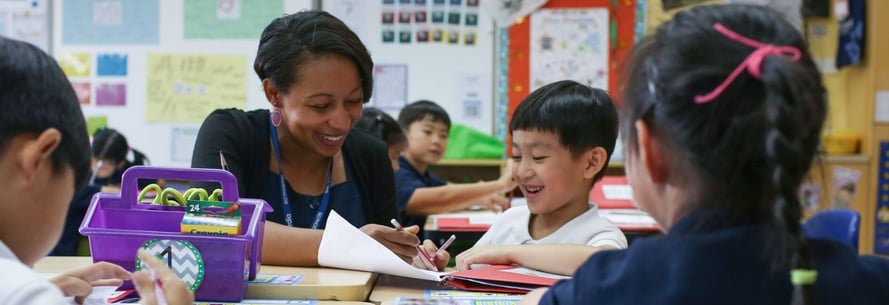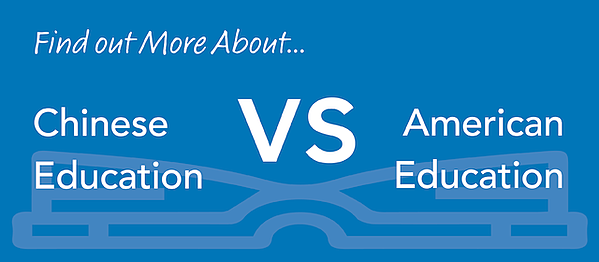
Living in Shanghai, you may be familiar with the Chinese educational style. A Chinese school is vastly different from what a parent might see in American schools, and while both offer advantages and disadvantages, the latter is designed to benefit students looking to study post-secondary in the U.S.
Below, we’ve outlined three major areas where Chinese schools differ from American schools so you can have a better understanding of what your children may experience should you choose to send them to an institution offering an American curriculum.
Though there are many differences between Chinese and American schools, there are also some similarities. Click here to learn more.
1. Learning Styles Have a Different Focus
In a Chinese school, the learning style focuses on memorization and other rote styles of learning. This knowledge of accumulation is deemed valuable in Chinese society because of the importance placed on high exam scores.
Criticisms, discussions, and tangential questions are often discouraged in a Chinese school, as the teacher is the sole source of knowledge and students are to only listen while dutifully taking notes and studying quietly.
Students in a Chinese school are also not allowed to use a calculator throughout their education, which helps lead to greater knowledge in Mathematics as well as reinforce strictness and precision, two important values in Chinese education.
In an American school, the focus is placed more on problem-solving and having a deeper understanding of subject matter rather than memorizing facts and statistics.
American schools want their students to be able to apply their knowledge to real-life problems. Where a Chinese school is more academically rigorous, an American school is more holistic and well-rounded, while still remaining academically challenging for students but encouraging student assuredness, self-determination, and independence.
In an American school, calculators are a welcome addition to the classroom, as the knowledge of how to solve the problem is more valuable than being able to solve it without any tools.
In many ways, the variations in learning styles stem from the differences in Chinese and American cultures.
“In a Chinese classroom, they have such a respect for their culture, whereas, in the U.S., we have more respect for a creative or new idea rather than understanding an ancient idea,” said Genevieve Ermeling, our Assistant Head of School in charge of teaching and learning.
2. Importance of Test Results Varies
In a Chinese school, students face an incredible amount of pressure to perform well on exams. Should a student not earn as high of a grade as expected, that failure is their responsibility.
While this pressure can result in resilience in some students, those who struggle to reach these standards can have serious mental health problems, according to an article published by Kaifang Zheng and Cirecie A. West-Olatunji sponsored by American Counseling Association.
In an American school, if students miss benchmarks in standardized testing, the blame can sometimes fall on the shoulders of the teachers. Student outcomes and teacher performance are directly linked, which is meant to encourage the best performance from educators.
American education puts less emphasis on test results than in a Chinese school, but examinations are still important. Expectations are set for students at each grade level, but an American school welcomes a more personalized approach which allows students to progress at different paces based on their abilities.
“Western education tries to personalize learning a bit more, whereas in China, there is this bar set for the grade level and wherever that bar is, that’s where everybody is trying to meet,” said Genevieve Ermeling.
The American classroom can be a culture shock to those accustomed to a Chinese classroom. To learn more about the benefits of learning in an American classroom for your children, click here.
3. Creativity in the Classroom
In a Chinese classroom, there is little focus on finding creative ways to learn, as the focus of school is memorization and building foundational knowledge. Education is viewed as a series of tasks to overcome, often with as much efficiency as possible and a focus on the challenge rather than the journey.
Chinese culture views school as the foundation for student education, where American culture views school as an opportunity to cultivate student creativity, problem-solving and knowledge application skills.
In an American school, there is a lot of value placed on making the learning experience fun for students and imbibing creativity into what could be a dull or uninteresting topic to some students. Education is viewed less as a challenge and more as something to be celebrated, which helps to develop a lifelong love of learning in students.
By encouraging students to participate in group activities and discussions, students in an American classroom are more engaged in the subject matter and are comfortable asking questions and delving deeper into the content.
The importance of creativity is also reflected in how both school systems either encourage or discourage extracurricular activities. In Chinese schools, students often do not have the time to participate in extracurricular activities because of the focus on their studies. But American schools value the cultivation of creativity, cooperation, and leadership skills as well as academics, resulting in students actively participating in sports and clubs.
Finding the Right Balance of Both
Finding a school that offers a curriculum as rigorous as what is found at a Chinese school that still values the creative freedom of an American school will provide your children with the benefits of both.
“I think too often we say one is better than the other when both have strengths and you can see that in the students who have been educated in one system versus another, they are all good at something. At an international school, you give your children the chance to be good at two things,” said Ermeling.
Though the two curriculums have many differences, they also have some similarities. When selecting which will provide a better learning environment, it’s important to take a look at the classroom culture and take note of which will help your children get into their best-fit college or university.
Click the link below to take a look at a Chinese education system vs an American education.





